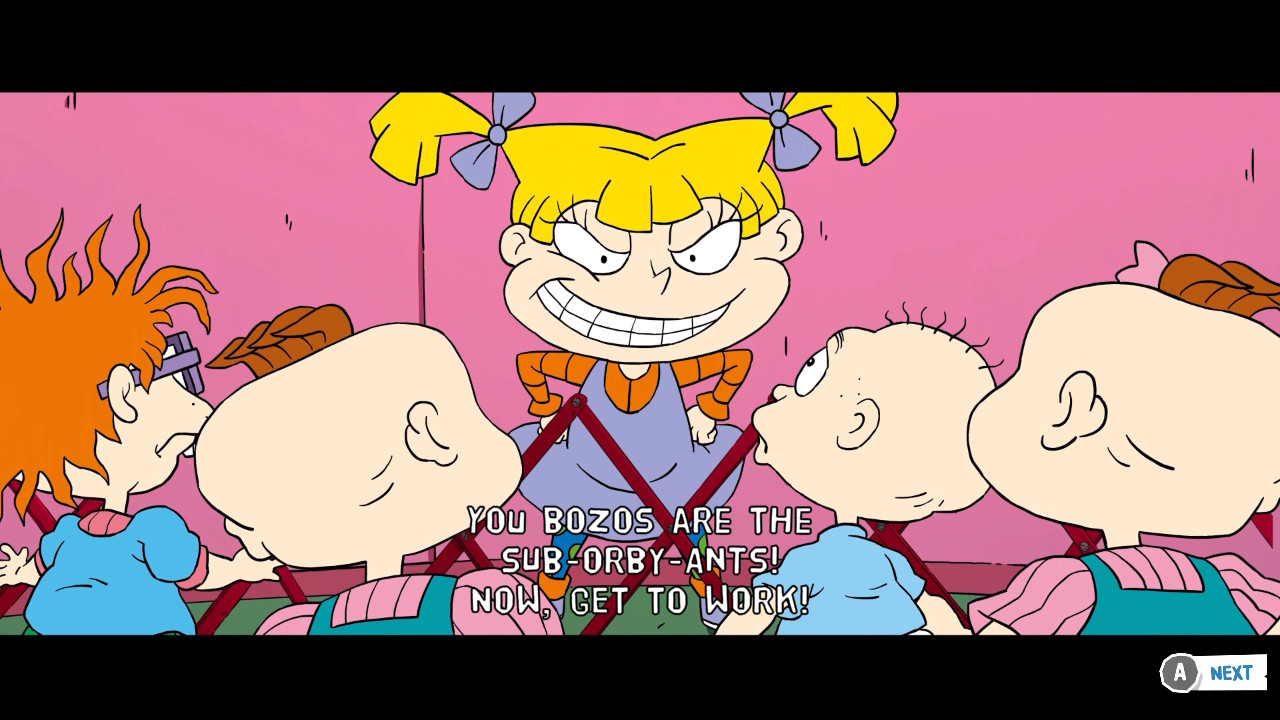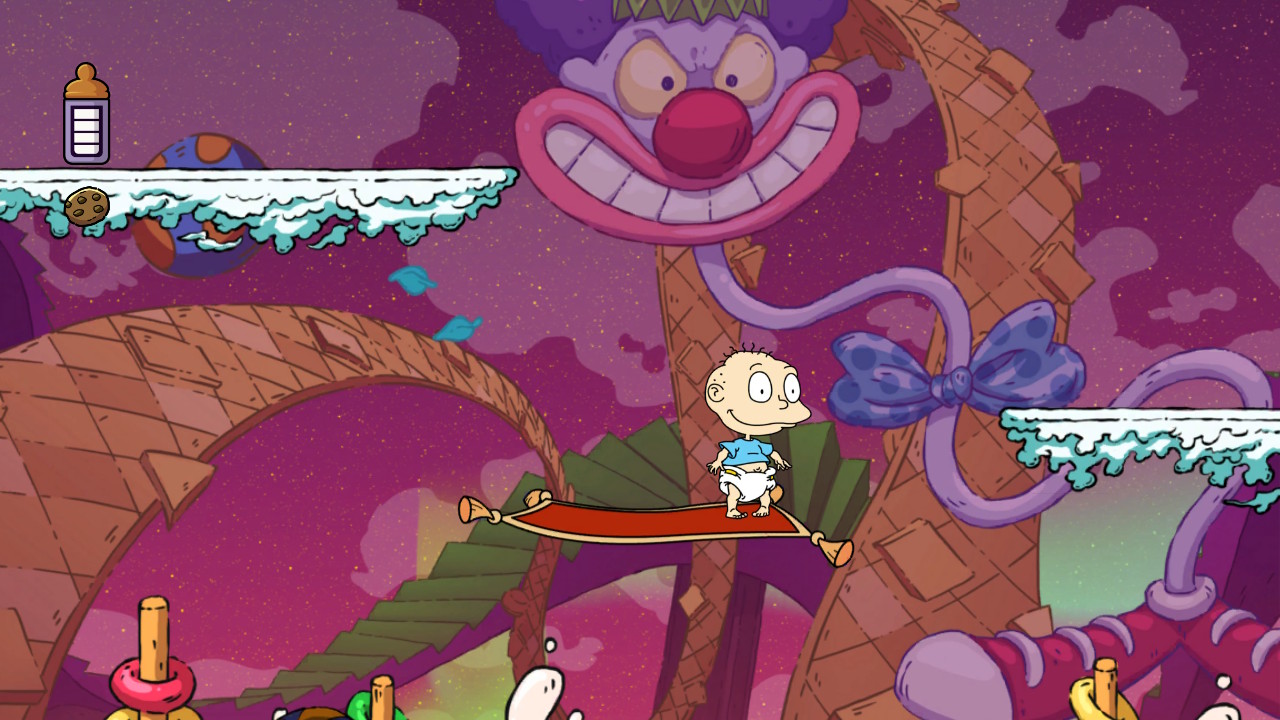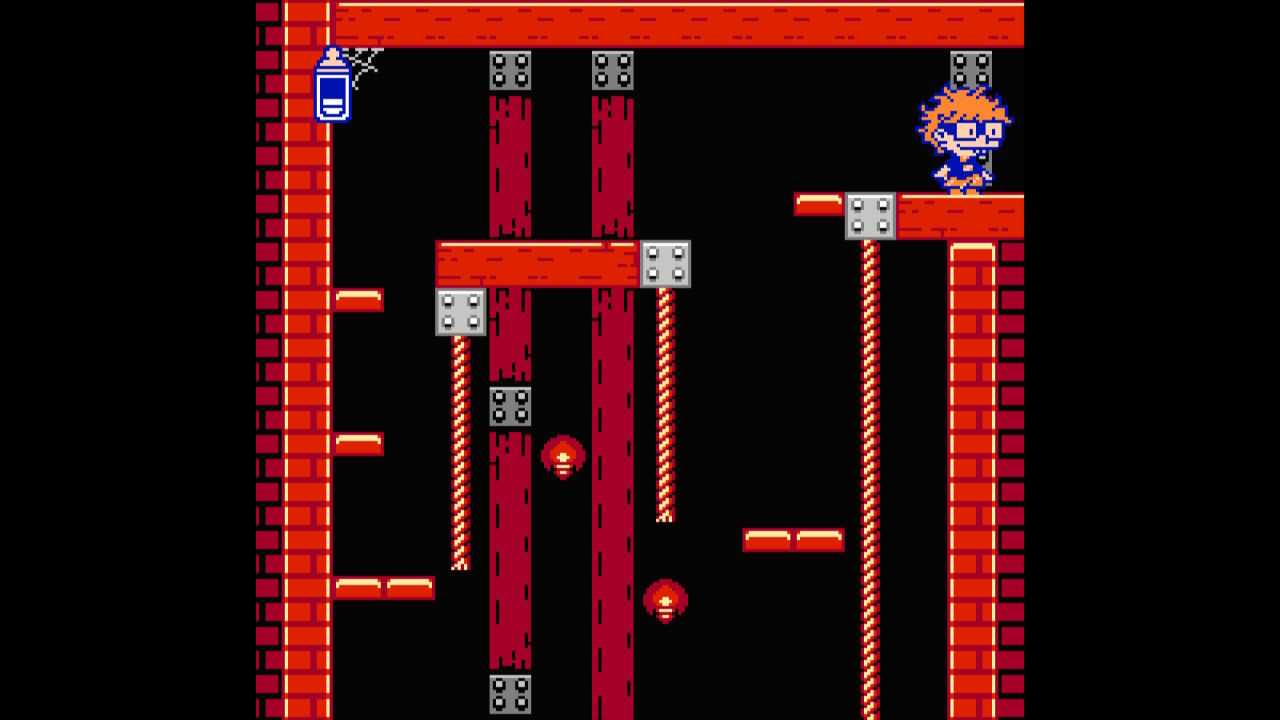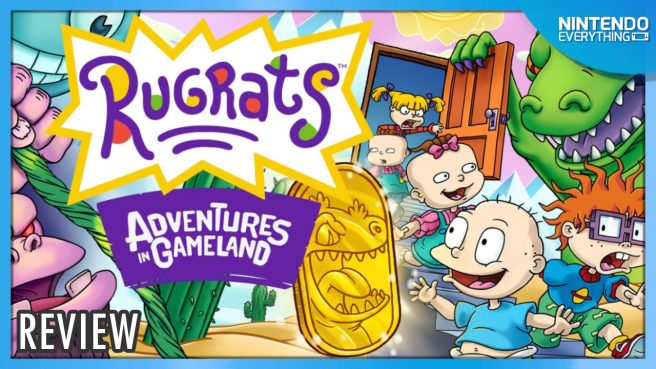System: Switch
Release date: September 9, 2024
Developer: Wallride
Publisher: The Mix Games Inc.
Rugrats is one of those cartoons that seems to get better with age. As a child I enjoyed watching the adventures of the babies as they transformed the everyday into something new and exciting, and as an adult I can appreciate the dry humor and now very relatable struggles of their adult parents. Although they have featured prominently in Nickelodeon titles, it has been some time since the Rugrats have had a game to themselves. Rugrats: Adventures in Gameland, their first solo outing for many years, feels like a platformer taken straight out of the era when they were at their most popular, for better and for worse.
Adventures in Gameland begins with the original quartet – Tommy, Chuckie, and the twins Phil and Lil – watching a commercial for a new Reptar game, which they want to play. Angelica points out that babies can’t play video games, and Chuckie points out that they have no money to buy it anyway even if they could. Naturally, Tommy has a plan: they might not have money, but they do have Reptar coins, and if they can gather enough of them from the various places around the house, they’ll be able to enter the TV and play the game. Thus their epic quest begins, taking you across the house and into a variety of locations brought to life through imagination as the normal and mundane becomes a series of perilous platforming challenges.
The presentation of Adventures in Gameland is one of its strongest attributes and is going to draw fans instantly, as it looks and feels like a HD version of the classic cartoon. The babies themselves also have fantastic animations that are bursting with their individual personalities as they jump, ground-pound, and (if you fail) cry their way through the game’s stages. Their idle animations are particularly entertaining: it never gets old watching Chuckie cower fearfully as he looks around, or Phil absently pick his nose and look utterly bored. The story unfolds through a mix of static character portraits and a few brief moments of animation, and it’s unfortunate that there is so little of it when it is of such a high quality and really captures the magic of the original show. The music complements the visuals perfectly, being composed mostly of clever variations of the show’s theme music that perfectly fit the situation, whether you’re navigating your way through the stages or facing off against one of the bosses at the end.
Adventures in Gameland is quite a short game, having only six stages. Once you’ve picked your preferred character you’ll be greeted with a delightful title screen taken straight from the TV show (complete with the iconic sound effects, of course) and then placed in the stage, which begins as a normal-looking location in Tommy’s house before being transformed into a landscape of childish wonder (or perhaps nightmare in some cases) and imagination as soon as the adults are out of sight, complete with bizarre backdrops, toys and other normally non-threatening items transformed into enemies and obstacles, and a lot of platforming.

Your ultimate objective is to unlock the barrier at the end of the stage by locating the screwdriver, and then defeat the boss lurking behind it. There are four Reptar coins in each stage, with three being scattered throughout the stage itself for you to find, and the fourth being awarded for defeating the boss at the end. You’ll need to acquire most of these to access the sixth stage and complete the game, although you can actually bypass one of the stages entirely if you acquire all of the Reptar coins in the other four. Stages are relatively linear although there are several side paths to be taken that inevitably loop back around to the main path, making it difficult to get truly lost.
Of course it’s not quite as simple a task as it sounds, and I found Adventures in Gameland to be extremely challenging at times. The lack of accessibility options generally included in modern titles to allow players to bypass or simplify more difficult platforming sections is often frustrating, and likely to be jarring if you aren’t used to less forgiving gameplay. The platforming demands a high degree of precision, and enemies will frequently impede your progress and turn what would otherwise be a simple leap into a nightmare of positioning and timing that you will undoubtedly fail several times before finally getting it right…only to have to do something equally difficult a few moments later. The game feels tough but fair thanks to clear enemy movement patterns and tight controls that allow for that necessary precision, but at times it can cross that line and feel distinctly unfair in how it punishes you for failing. Although you’re given a brief invulnerability window when you’re hit by an enemy, the knockback is usually significant enough to force you off whatever you’re currently standing on, sending you plummeting down a bottomless pit or (arguably worse) part of the stage below that you had already painstakingly pushed through and will now have to do again.
Surprisingly, the bosses at the end of the stages aren’t particularly difficult to defeat, with each of them having easily identifiable attack patterns and weak spots for you to exploit, and although their relative lack of challenge and shorter duration might feel a bit anticlimactic to some, I found this step down in difficulty after the platforming it took to reach them to feel more rewarding than disappointing, and was relieved they didn’t have multiple different stages or forms to contend with. Their designs are equally as memorable as the enemies you’ll face in each stage, being taken straight from the TV show, and they always feel like a satisfying ending to a stage. The final boss in particular was one of my favorites, and was entirely fitting for the game.

It’s important to consider which baby you choose, as each has their own individual Jump and Lift stats that makes them play quite differently from one another. For example, Chuckie has the highest jump rating of the four and can easily clear gaps or ledges that the others can’t unless they use an enemy as a springboard or stack blocks. Phil, with the lowest Jump stat, will usually need help to platform his way across levels, but his lower jump height makes him ideal for crossing smaller gaps without overextending. I found myself using Chuckie and Lil (who has a small glide if you hold the jump button down that proved invaluable for adjusting trajectory mid-jump) for most of the game, and the difficulty of the platforming can change quite noticeably depending on which baby you control. You’ll need to approach levels quite differently with each one, taking into account how high you can jump, how far, and how long you’ll stay in the air, and whether there are enemies you’ll need to watch out for. This is particularly important if you’re playing on the hardest difficulty, Big Kid, which doesn’t allow you to swap between babies during levels.
You have a total of four hit points depicted by the milk bottle at the top of the screen, and the only way to replenish these is to obtain milk bottles by defeating enemies, which isn’t guaranteed and is likely going to be more trouble than it’s worth in most instances. You can gain an extra life of sorts by picking up cookies in the level, which will fully replenish your health once it’s depleted, but these are few and far between and typically only appear before bosses at the end of the level. Checkpoints are scarce, and although failing will see you teleported back to where you fell, dying will deposit you back to the last one, which could be several screens away from where you were previously or even the start of the level.
The game has three thematically named difficulty options. Newborn and Baby will both allow you to swap between the babies at any time, with the former also giving you unlimited retries. The hardest, Big Kid, won’t allow you to swap babies at all during the level. Otherwise, the game is exactly the same no matter which difficulty you choose, so your selection doesn’t make the game easier as much as it does give you more chances to retry parts you get stuck on. Each baby has their own separate health bar, letting you manage the damage you take to some extent by swapping between babies when their health gets too low and you risk being deposited back to the last checkpoint if you play on Newborn or Baby. Unfortunately you’re still going to need to get past whatever you’re stuck at, and you’ll get no help from the game to do it. If you get stuck at a particular point (as I did several times during my playthrough) it can become quite a frustrating block to progression until you find a way past it.

It’s a little unfortunate that more accessibility options haven’t been included to mitigate the challenge and cater to a wider variety of player preferences, but being this challenging is certainly no point against Adventures in Gameland, and is going to be something that players craving something more old-school will appreciate. Nonetheless, it is definitely a factor to consider if you were expecting something with modern comforts, because there are none to be found here. In many ways, this feels like a product straight out of the 90s: it demands platforming precision and pulls no punches if you make a mistake.
Adventures in Gameland also offers a 2D mode to further capture that classic platformer aesthetic, and you can swap between styles at any time during play in the menu. The entire game will be devamped into NES-style visuals, with enemies and level layout being identical to the default HD style, but presented in classic pixel format. You can adjust the music separately to a chiptune variation too if you’d prefer, and having these on a separate toggle was a nice inclusion. Interestingly I found that parts of the game actually became easier playing this way: as beautiful as the HD backgrounds are they can be quite cluttered, and it can be difficult to figure out what you can interact with as everything blends together in a visually appealing but somewhat confusing mess. At one point during a level I was stuck for several moments before realizing I could actually crawl through a gap, something I never had any problems identifying when playing in the classic 2D style, where it is much easier to distinguish between foreground and background details.
Whilst in HD mode you can also opt to play the game either in fullscreen or with borders, and although you may be tempted to fill the Switch’s screen, this comes with the unfortunate and often fatal drawback of limiting your field of vision. More than once I ended up failing a level or a jump because I couldn’t see an enemy that was off-screen, or that there was a pit below me: this was never an issue when playing with borders or in 2D mode, both of which give you a much wider field of vision. Unfortunately, Adventures in Gameland often requires you to sacrifice form for function in order to succeed.
The Verdict

Rugrats: Adventures in Gameland is pure nostalgia, and playing it made me feel like a kid again, for better and for worse. The presentation is true to the TV show to a fault, and the ability to swap between HD and classic 2D visuals is a unique and noteworthy feature. Most of the time, it’s a game that is tough but fair. But the lack of accessibility features we now take for granted is something you might want to keep in mind if you’re considering picking it up, as there is nothing to mitigate the potential frustration its trickier moments can cause.
A copy of Rugrats: Adventures in Gameland was provided by the publisher for the purpose of this review.
